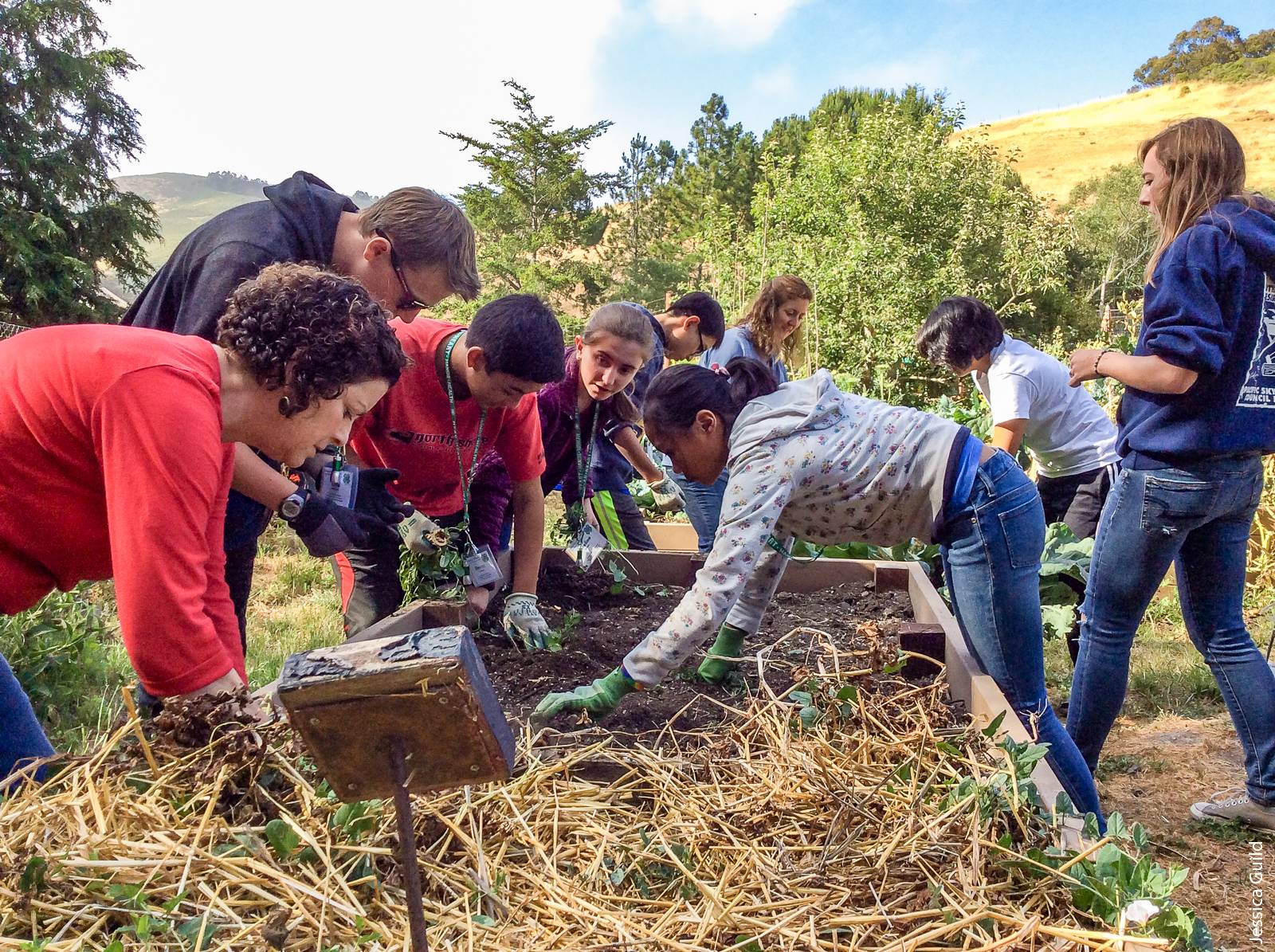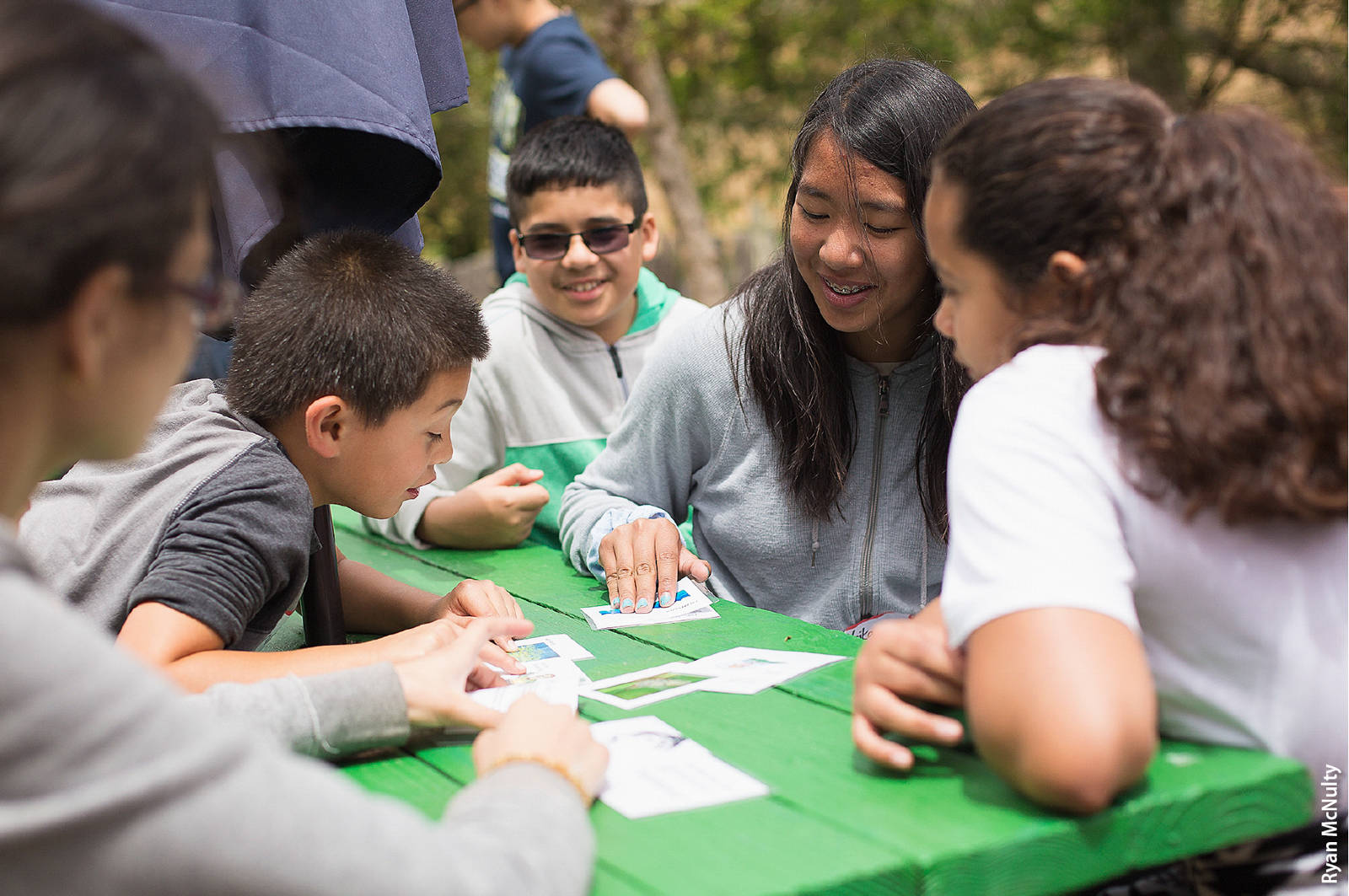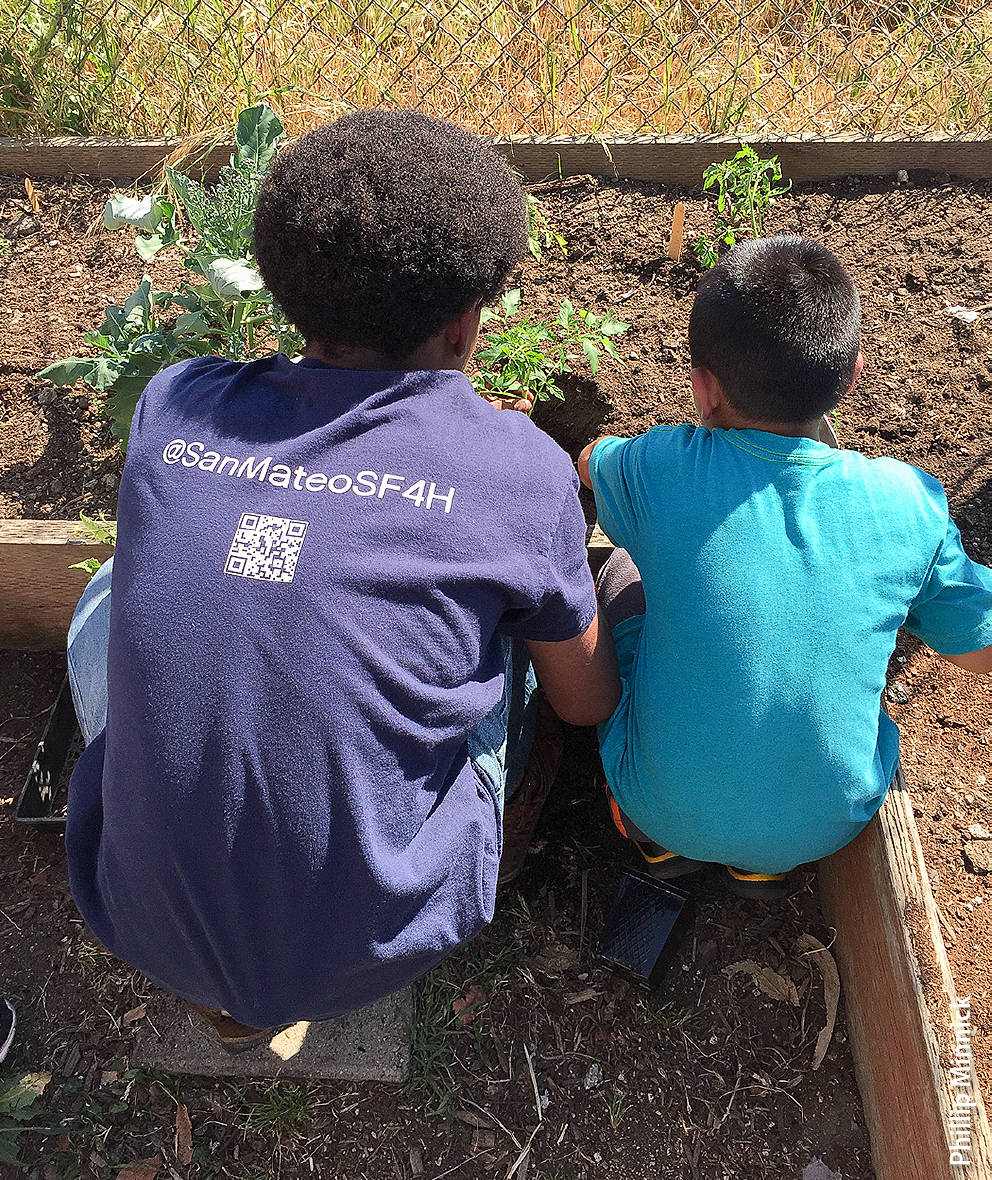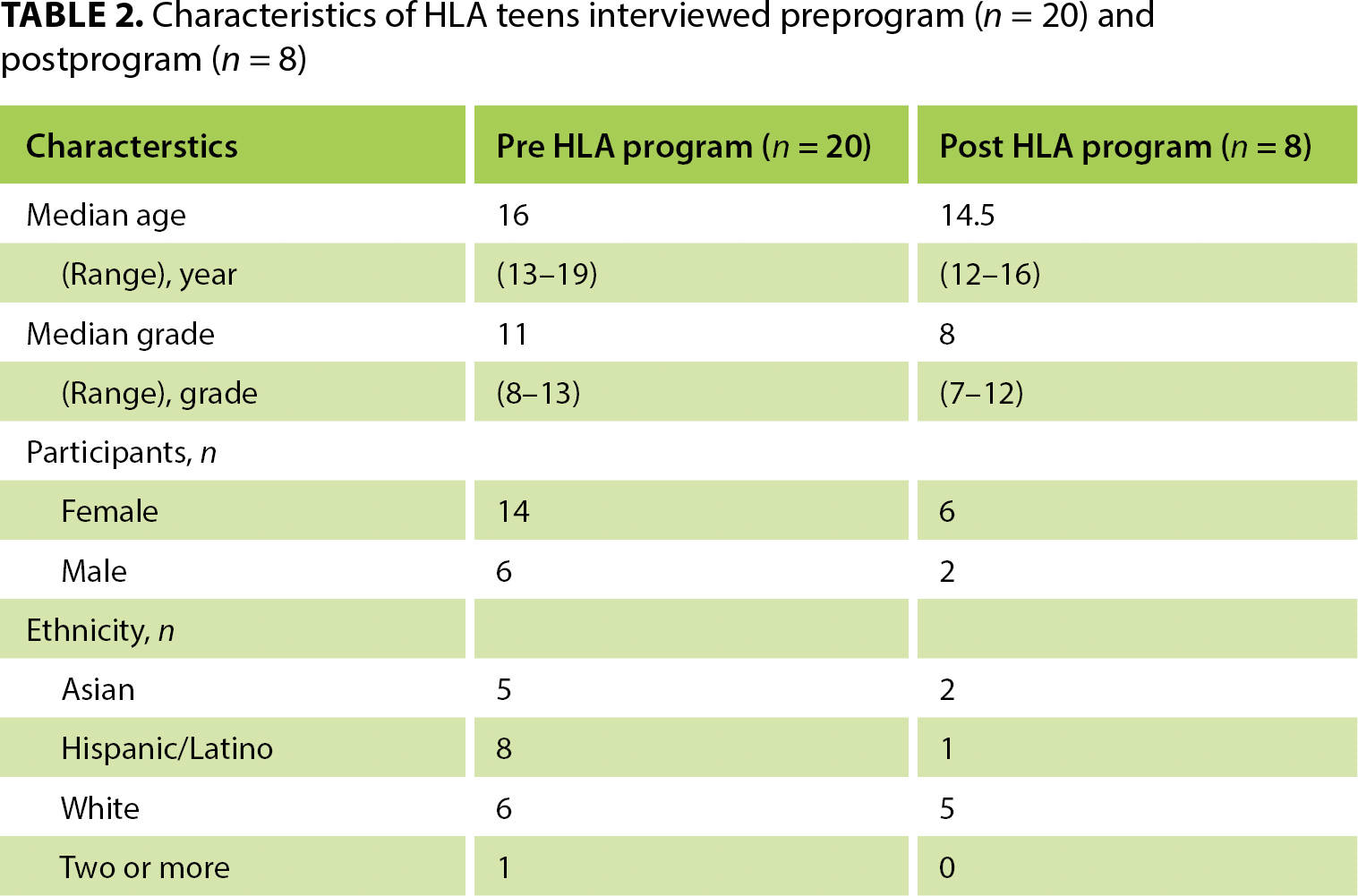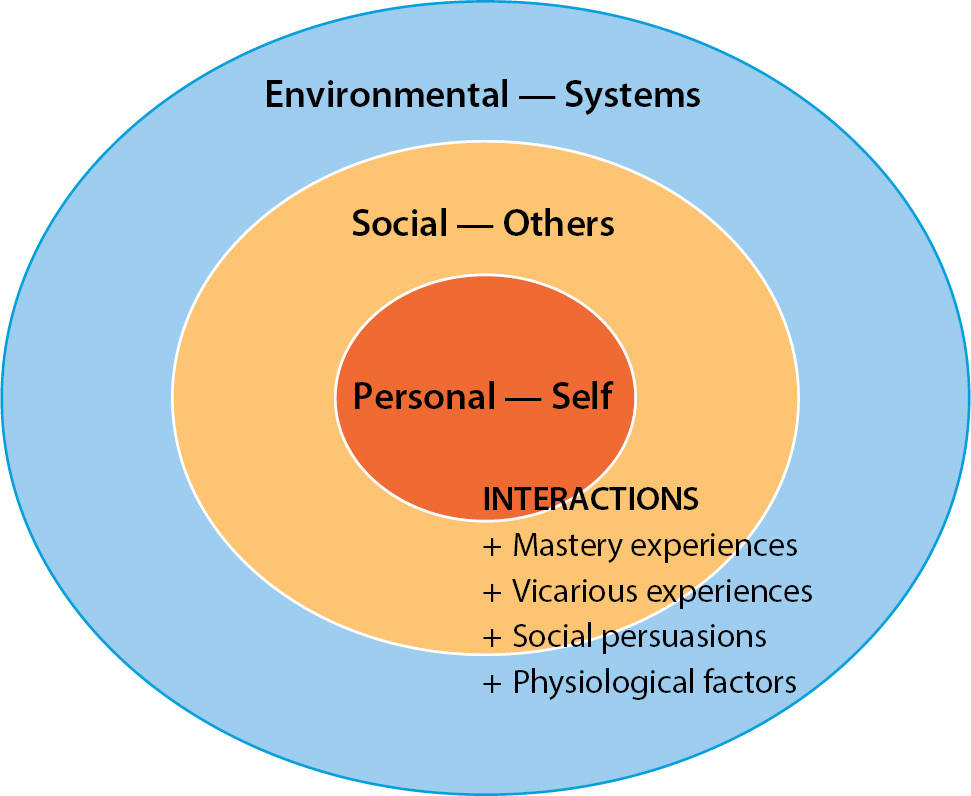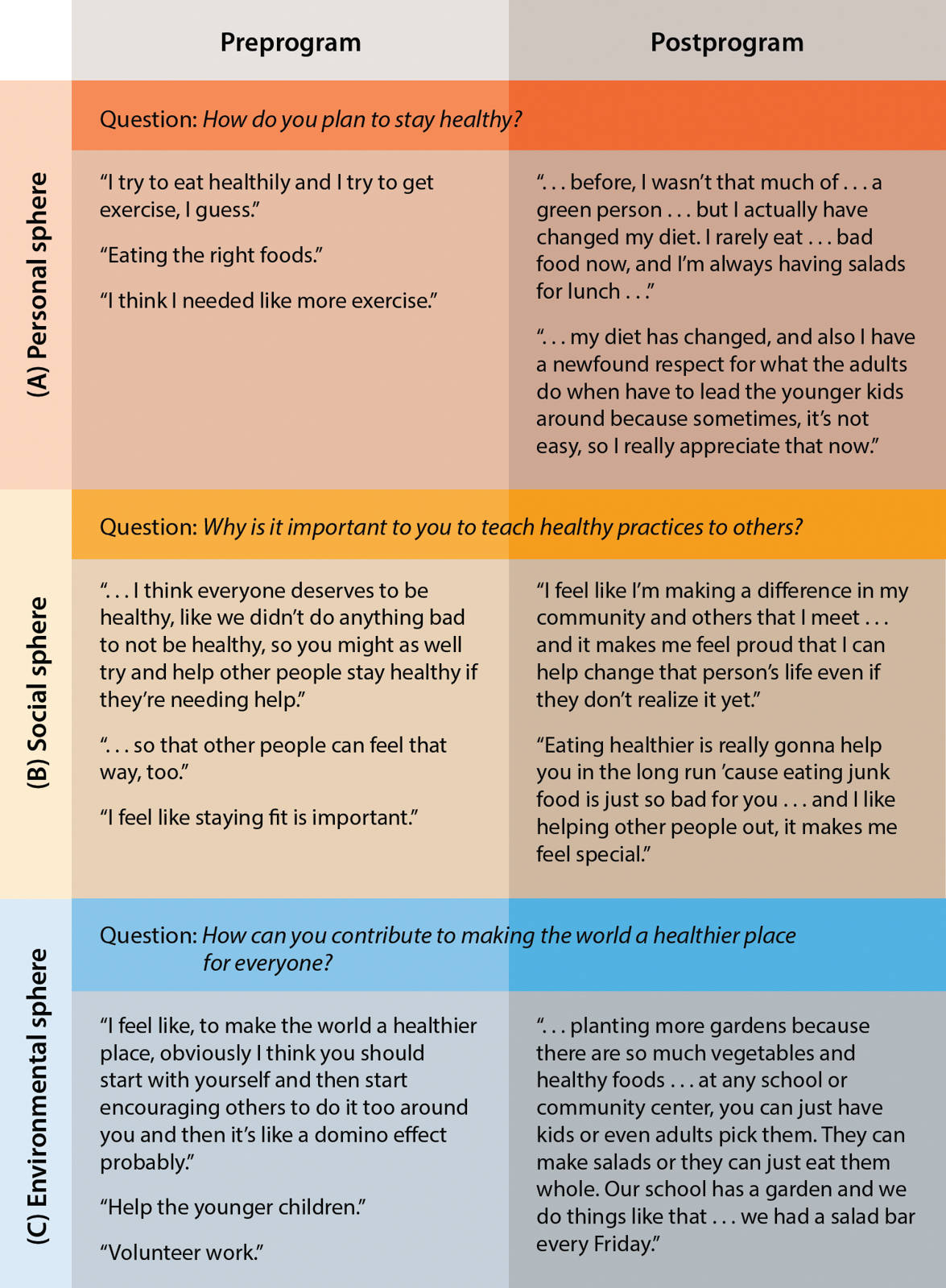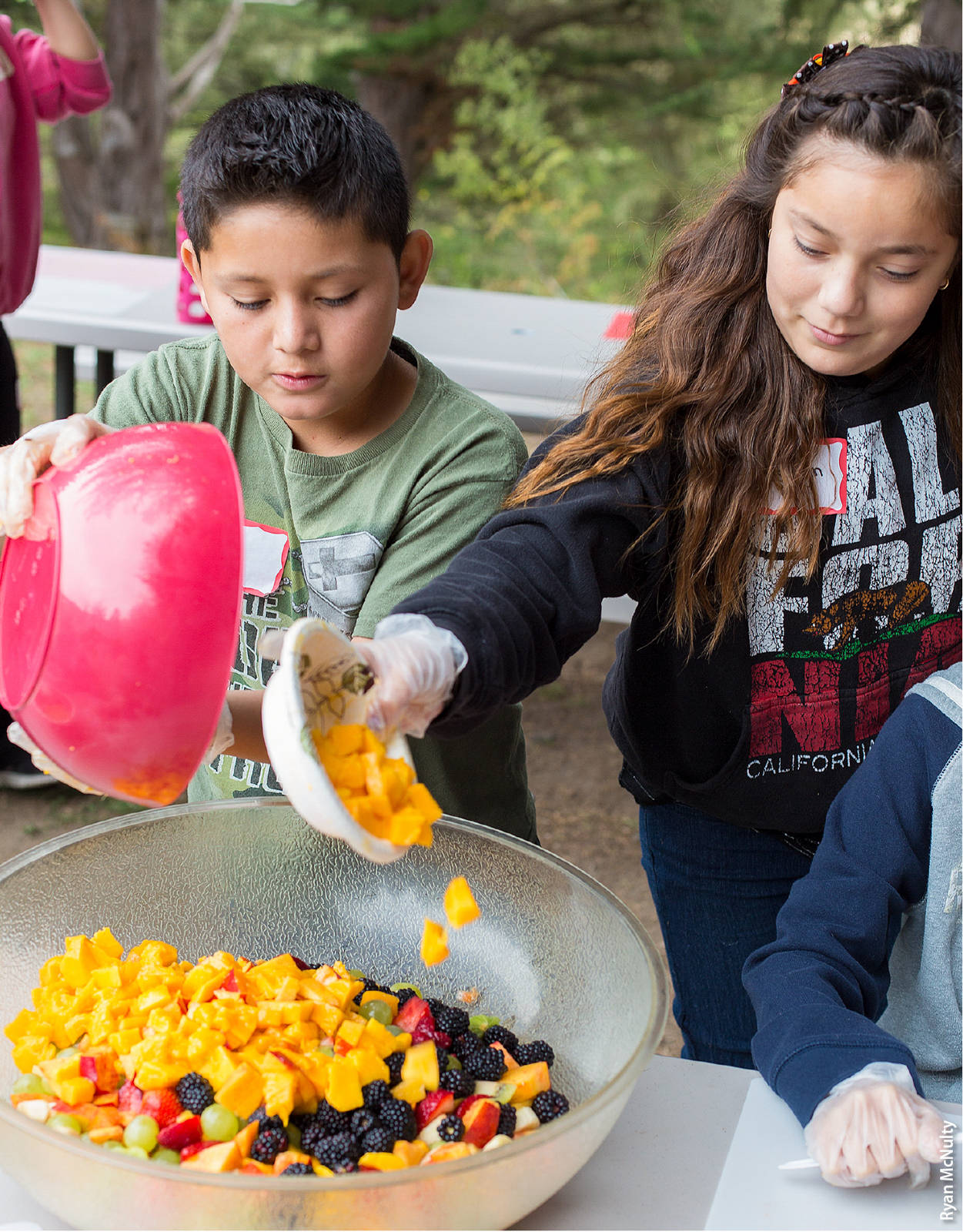All Issues
Teens-as-teachers nutrition program increases interest in science among schoolchildren and fosters self-efficacy in teens
Publication Information
California Agriculture 72(2):135-143. https://doi.org/10.3733/ca.2018a0016
Published online June 26, 2018
PDF | Citation | Permissions
NALT Keywords
Abstract
The Healthy Living Ambassador Program brings health, teen leadership, and teamwork to California's elementary school gardens through interdisciplinary UC Cooperative Extension collaboration, community-based partnerships and teen teaching. During spring 2015, teen ambassadors trained by Extension educators and volunteers at UC Elkus Ranch in San Mateo County taught nutrition science, food cultivation and healthy living skills in an 8-week, garden-based, after-school nutrition and physical education program for elementary school children in an urban setting. We conducted a pilot study using a mixed-methods approach to measure and explore the program's impact on children's vegetable selection and consumption preferences, as well as perceived self-efficacy in teen healthy living behavior. The children trended toward an increased preference for gardening, cooking and science, and teens displayed an increase in perceived health self-efficacy.
Full text
Urban food deserts, built environments and technology advancements (e.g., smart phones and computers) contribute to poorer diets and less physical activity, which tend to increase risks for childhood obesity (Brody 2002). Poor diet quality disproportionately affects our poorest children and ethnic minorities (Hiza et al. 2013; Kirkpatrick et al. 2012). Further, students' academic achievement is directly linked to their nutrition status and health (Glewwe et al. 2001), which includes a healthy mind and a belief in the capability to organize and execute a successful course of healthful action, known as self-efficacy (Bandura 1997). Self-efficacy instigates the adoption, initiation and maintenance of health-promoting behaviors (Schwarzer and Luszczynska 2006) that ultimately contribute to the overall quality of life. Therefore, healthy living skills woven into educational programs that include healthy eating, physical activity and development of youth self-efficacy in healthy behaviors may improve the health of all youth (both teens and children) regardless of race or income.
A pilot study conducted by UC Cooperative Extension showed that the Healthy Living Ambassador Program increased children's interest in science and gardening and that teen teachers developed self-efficacy in healthy behaviors.
A major challenge for nutrition education is how to develop and implement interventions that support vegetable intake while also engaging youth. A garden-enhanced nutrition education program can improve fruit and vegetable intake and promote healthful eating behaviors if educational programs connect children through fun activities (Heim et al. 2009). School and community gardens present considerable potential and have been proposed as a practical and effective tool for connecting youth to nature, food sources and each other, possibly yielding healthier lifestyles and higher academic achievement (Robinson-O'Brien et al. 2009). Additionally, gardening experience may encourage families to grow food in gardens, which can lead to an increase in vegetable consumption as well as greater food security in low-income households (Algert et al. 2016).
Despite these benefits, school garden spaces often lack adequate support for growing food and hosting educational activities. While thousands of school garden beds have been built across California (Eastin 2013), shifts in school administration, local values and educational priorities often determine the support for garden programming (Boyle 2013). Many teachers do not feel they have the experience, interest, time, or appropriate curricula to use the garden as part of their academic instruction (Graham et al. 2005; Graham and Zidenberg-Cherr 2005). Moreover, most schools have no paid staff specifically to manage or teach in the garden. Because teachers are primarily evaluated on classroom instruction, outside garden education remains a low priority and is often unsustainable.
Many schools lack the resources needed to host educational activities in their gardens. The HLA Program aimed to fill that need by training teens to teach the children in their communities about gardening, nutrition, science and fitness. During the program, teens will adopt healthier behaviors themselves.
Teens may be able to help fill this resource gap. In some contexts, teens as peer educators can be as effective (Karcher et al. 2002) as adult teachers in eliciting healthy behavioral changes in children, or even more effective (Smith and Holloman 2013). Furthermore, they can be enthusiastic, nonparent volunteers who contribute to a successful after-school gardening program (Scherr et al. 2013). This positive effect is not surprising because it has been shown that near-peer-assisted learning can improve academic performance in young adults (Williams and Reddy 2016) and in low-income and minority elementary school students who live in urban areas (metropolitan areas with populations > 1 million and cities > 100,000; Rohrbeck et al. 2003).
Teens taking leadership roles in supportive environments may develop self-efficacy in healthy behaviors for themselves, an added benefit of peer-assisted teaching. Efficacy beliefs have been identified as correlates of self-reported healthy behaviors in adolescent populations (Motl et al. 2007; Schwarzer and Luszczynska 2006). It is expected that teens with the opportunity to teach in school gardens will adopt healthier living behaviors by practicing food cultivation, serving as ambassadors for health, and teaching children about nutrition. A further benefit of this near-peer teaching is that it provides teens experiences to develop their own self-efficacy in healthy living that may affect their long-term behavior and, additionally, influence their peers and their community.
An HLA teen talks with an elementary school student about growing vegetables. Teens as peer educators can be as effective as adult teachers in prompting healthy behaviors in children.
The Healthy Living Ambassador (HLA) Program is a collaboration by UC CalFresh, 4-H Youth Development and UC Elkus Ranch in partnership with local schools to organize, connect and grow capacity in resources (e.g., teachers, curriculum, materials) to bring about healthful impacts in local communities. The UC CalFresh program's goal is to implement policy, system and environmental changes in underserved schools in which more than 50% of students qualify for free and reduced-price meals, and the 4-H program (across the country) seeks to identify urban program models and delivery methods that reach broader audiences, including youth from low-income and ethnic minority backgrounds. The primary purpose of the HLA after-school program is to inform, develop and empower teens by providing a vehicle to positively impact personal, community and planetary health. Using a garden-based curriculum and hands-on activities, teens teach younger children about nutrition, fitness and gardening while presenting a comprehensive and ecological approach to healthy living, agriculture and the environment.
To evaluate the HLA Program's effect on youth (children ages 7 to 8 and adolescents ages 12 to 19), we launched a pilot study during the spring 2015 season and assessed the effectiveness of the HLA Program intervention on children at a subset of San Mateo County school garden sites with (n = 1) and without (n = 1) the HLA Program, and on teen HLA teachers at five sites. We wanted to (1) determine the effects of a garden-based nutrition and physical activity program on youth vegetable selection and consumption preferences, (2) determine the effectiveness and needs of teen teams as teachers and (3) identify any potential benefits of creating an integrated community and Extension partnership, focusing on teen health self-efficacy and teen empowerment.
The HLA Program in San Mateo County
In 2014, the HLA Program was launched in San Mateo County through initial seed funding focused on healthy living from the National 4-H Foundation. Currently, the program is supported locally through San Mateo County's partnership with UC Cooperative Extension and UC CalFresh (2015–18), and it has a blended, coordinated staff support model that includes UC Cooperative Extension, local elementary schools, after-school programs, and teens. The HLA Program completed its fourth season in San Mateo and San Francisco counties in spring 2017 and has a fifth season planned for spring 2018, and there is interest in the program being scaled up to other counties.
From late 2014 into early 2015, UC CalFresh and 4-H Youth Development Program staff recruited 12-to 19-year-old youth from local middle schools, high schools, community colleges and other youth organizations within proximity of elementary school gardens in need (those that were not being used as an education resource and that were fallow or overgrown). For the spring 2015 season, the HLA Program was implemented in five selected elementary schools in Daly City and Redwood City that had existing after-school programs and embraced offering an enrichment activity once per week for 60 to 75 minutes over an 8-week period. At least 50% of the elementary students at these sites qualified for free or reduced-price meals (Ed-Data 2015). The UC Davis Office of Research Institutional Review Board Administration reviewed and approved of the Healthy Living Ambassador Garden Study (IRB #7187551).
School administrators, with support from existing after-school programs, agreed to back implementation of an HLA Program curriculum, as an enrichment activity, delivered by teen teachers (HLAs). The HLA Program curriculum was adapted from the Health and Nutrition from the Garden (HNG) curriculum (JMG 2002) and infused with CATCH (Coordinated Approach to Childhood Health for K-5; catchinfo.org ) activities to ensure physical fitness (table 1); the curriculum and activities were approved by the UC CalFresh statewide network.
Before the program commenced, teen HLAs participated in an intensive two-day, overnight training at UC Elkus Ranch in Half Moon Bay to develop their knowledge of and skills and practice in the basics of food cultivation, nutrition, fitness, community leadership, early childhood development and instructional practices for teaching elementary students healthy living skills and how to grow vegetables. Training was provided by UC CalFresh, 4-H, UC Elkus Ranch staff, and UC Master Gardener volunteers.
Upon completion of the training, teen HLAs returned to their communities in San Mateo County, where they taught and mentored young students during after-school hours in a school garden. In addition to planting and nurturing eight to 10 different cultivars (e.g., lettuce, radishes, tomatoes, carrots, beets, parsley, edible flowers, etc.) with the children, teen HLAs built their leadership skills with adult mentors (after-school program partners, UC CalFresh staff, and 4-H staff and volunteers) who provided background support. The 8-week program culminated with Lettuce Wrap-Up, a harvest celebration and feast from the garden that welcomed family and faculty members.
Whenever it was feasible, teams of teen HLAs (three or four youths) served elementary schools within walking distance of their own schools (and, when possible, served elementary schools they had attended as children). The out-of-school (after-school and informal garden space for the HLA Program) setting is conducive to developing personal relationships, as well as nurturing experimentation and relaxation of teens, components that are often lost during the transition from elementary school to middle school (Akos 2002).
Preferences rise for gardening, cooking and science
Two populations of mixed second- and third-grade elementary school children, either participating in the HLA Program (intervention, n = 71) or not participating (control, n = 22), were evaluated preprogram and postprogram using a paper survey that we adapted from three California 4-H surveys: the Children, Youth, and Families At Risk (CYFAR) Youth Survey, the Self-Efficacy Survey (Baranowski et al. 2000) and the Food Preference Survey (Cullen et al. 2003). Both the intervention site and control site were measured at two time points (approximately 10 weeks apart).
To evaluate changes in preprogram versus postprogram preference for vegetables, gardening, cooking, exercise and science in children, we compared intervention versus control site changes of these parameters using the Mann-Whitney test on the children's preferences (as indicated by the faces they circled — sad, happy or neutral — on the paper survey). The Likert scale we used was based on sad face = 0 and happy face = 5. Comparisons between changes in scores were considered statistically significant when p ≤ 0.05 (two-tailed).
Compared to the control group, children in the intervention group reported larger increases in their preference for gardening (p = 0.002), cooking (p = 0.044), and science (p = 0.002) after participation in the HLA Program (fig. 1). Reported changes in preferences for vegetables (p = 0.083) and exercise (p = 0.569) did not significantly differ between the intervention and control sites, though preferences for vegetables leaned in a positive direction. Preference for exercise did not follow this trend, but preference toward cooking increased despite not being included in the program. This could be because neither exercise nor cooking were major components of the teaching of the HNG curriculum, or because “exercise” and “cooking” may have different meanings to a 7- or 8-year-old (which is a limitation of the survey). Additionally, children taking the survey often did not credit physical activity in the garden as exercise, even though it is considered a physical activity by UC CalFresh (V. Bolshakova, personal observation). Further, while the students prepared a lettuce wrap by combining mixed vegetables, the act of cooking (i.e., heating and mixing) was never part of the HNG curriculum or the children's HLA Program experience.
FIG. 1. Increases in elementary school children's preferences toward gardening (p = 0.002), cooking (p = 0.044), and science (p = 0.002) were significantly higher after the HLA program (n = 71) compared to controls (n = 22). The scale used was based on 0 = sad face and 5 = happy face. A Mann-Whitney test (two-tailed) was performed for these comparisons. Data represents mean and SEM.
Carrot is the preferred vegetable
Before the HLA Program began, we measured vegetable choice and consumption preferences in the same population of children at the intervention site in the after-school setting (n = 71) and, separately, in the group of teen HLAs during their initial day of training before lunchtime (n = 40). The intake assay, adapted from the Teacher Taste Testing Process Guide (Kaiser et al. 2012), consisted of approximately 1 ounce (28 grams) each of raw beets, carrots, daikon radish, grape tomato and snap peas — vegetables the youth grew in the garden during the program (fig. 2A). The vegetables were prepared by the research team within 1 day of the assay and the quantity consumed was measured by weighing the vegetable containers for each child and teen before and after the tastings. Children were encouraged to taste each vegetable and then to eat as much or as little as they wanted.
FIG. 2. (A) Example of a vegetable sampling box (beets, carrots, daikon radish, grape tomato and snap peas). (B) Carrot was the preferred vegetable selected and consumed by children (n = 71) and teens (n = 40) before participating in the HLA Program. (C) Children selected and preferred less grape tomato (p = 0.02) after participation in the HLA Program (n = 71) compared to controls (n = 18). A Kruskal-Wallis H test (two-tailed) was performed with a Dunn's multiple comparison test to compare groups. Data represents mean and SEM.
Of the five vegetables evaluated, carrot was the preferred vegetable consumed by elementary school children (37% of total vegetable consumption) and teens (32%) before the program (fig. 2B). This is not surprising, because carrots are common and accessible; nearly all HLA Program partner schools offered carrots or apples for the supplemental afternoon snack program, and carrot is among the most common vegetables consumed in the United States (USDA ERS 2014).
After the HLA program (10 weeks after the initial vegetable preference measurement), we repeated the assay with the same children. We were not able to collect an adequate number of postprogram vegetable assays from teens to conduct statistical analysis; therefore, post results for teens are not included. To determine the effects that the HLA Program had on preprogram versus postprogram selection and consumption of the five vegetables (beet, carrot, radish, grape tomato and snap pea) or their combined total, we used the Kruskal-Wallis H test to compare these changes to those at the control site. The consumptions were considered statistically significant when p ≤ 0.05 (two-tailed). Compared to the control, children at the intervention site had a smaller increase in consumption of grape tomato (p = 0.002) after participating in the program (fig. 2C). Changes in consumption of beets (p = 0.890), carrots (p = 0.324), radishes (p = 0.150), peas (p = 0.702) or total combined (p = 0.058) did not differ.
Teen self-efficacy
To understand the potential impact of the HLA Program on developing youth self-efficacy, we looked to our teen stakeholders as “sophisticated observers of their own life” (Corbett and Wilson 2001). Developing successful health interventions requires identification of variables that correlate to healthy behavioral changes (Baranowski et al. 1998). Quantitative studies have found mastery experiences to significantly predict self-efficacy (Britner and Pajares 2006; Usher and Pajares 2008) across behavioral domains, including health-related behaviors. In the HLA Program model, where teens are empowered to become teachers and models of healthy living in their communities, the teen viewpoint is arguably the most critical viewpoint (versus the children receiving instruction and/or adult mentors supporting the teen teachers) in developing and implementing an effective teen-driven health intervention program. Perspectives of teen's perceived self-efficacy in healthy behaviors provide useful insight into their world, where healthy practices may or may not be found. This qualitative investigative approach may provide additional insight into the current research base on health interventions in general. By focusing on teen voices, we hoped to gain perspective about their health efficacy and how that may translate into further developing individual and community health.
We conducted preprogram (n = 20) and postprogram (n = 8) semi-structured interviews with teen HLAs (demographics, table 2) regarding their views and experiences of, beliefs, and motivations around their own healthy behaviors and their HLA program participation. Preprogram and postprogram populations were selected based on convenience (or availability) to participate in the interviews, and findings do not represent comparisons of distinct individuals. Despite all reasonable efforts to regroup the teen HLAs for postprogram interviews and vegetable assays, coordinating a common time and place to meet proved challenging, despite the fact students were out of school for the summer.
Given the exploratory nature of this study, the convenience sampling technique was effective in helping identify and address shortcomings associated with our questionnaire design. Interviews were conducted in person with individuals or small groups (two or three teens) before the initial training (pre) and after the last garden lesson (post) and were transcribed and independently coded by all three authors. We then regrouped to discuss coding and combined themes into broad categories in Excel (2016).
We interpreted self-efficacy themes through the lens of social cognitive theory (Bandura 1977). Social cognitive theory explains how people learn and develop certain behavioral patterns that are built upon the interplay of personal, social and environmental spheres through interactions of mastery experiences (proficient or insufficient competency or sense of accomplishment), vicarious experiences (modeling or recognizing one's potential or lack thereof by comparison with another person), social persuasions (encouragements or discouragements that may alter one's confidence), and physiological factors (positive or negative interpretation of physiological states often accompanying stressful situations such as nausea or anxiety) (fig. 3). We evaluated teen health self-efficacy by scoring responses to three interview questions relating separately to personal, social and environmental spheres, particularly looking at vicarious and mastery experiences as sources affecting efficacy. Scores were given to answers that represented no answer (score = 0), vicarious experiences (score = 1) and mastery experiences (score = 2).
Baseline self-efficacy
Before the program began, many teens noted their involvement in sports as a part of their healthy living and wanted to learn more about health and gardening. Others realized that it was a personal challenge to be healthy. When asked “How do you plan to stay healthy?”, only about one-third of teens responded with a mastery experience in the personal sphere of the social cognitive theory model (fig. 4A). Many of their responses were brief and general vicarious answers (fig. 5A) that identified a process or model that might lead to a healthy outcome, but the youth felt they had not accomplished or mastered it. Several of the students highlighted that they wanted to develop leadership and teamwork skills working with children and fellow teens. Some realized the challenges of understanding the perspectives of other youth and being a positive influence on them.
FIG. 4. Self-efficacy assessments. Teens were interviewed before (n = 20) and after (n = 8) the implementation of the Healthy Living Ambassador Program. They were asked one question relating to each social cognitive theory sphere: (A) personal, (B) social and (C) environmental, and their responses were categorized according to indications of vicarious, mastery or no related experiences.
FIG. 5. Self-efficacy representative quotes. Teens were interviewed before (n = 20) and after (n = 8) the Healthy Living Ambassador Program. They were asked one question relating to each social cognitive theory sphere — (A) personal, (B) social and (C) environmental — and their responses were categorized according to indications of vicarious, mastery or no related experiences.
When asked the questions relating to the social sphere (“Why it is important to you to teach healthy practices to others?”) and environmental sphere (“How can you contribute to making the world a healthier place for everyone?”), only 5% of teens answered with mastery experiences, with the remaining teens providing vicarious responses or no response (figs. 4B and 4C). Most teens were not able to provide concrete examples of how they were models of healthy living to others or how they were actively participating in making their communities healthy. Moreover, teens were not sure how they could help others live healthier lives, although some mentioned they could talk to family and friends about healthy eating and be a role model for younger siblings.
Self-efficacy after the HLA Program
From our preprogram and postprogram interviews, we observed shifts in teen responses; broadly, teens focused more on vicarious examples during preprogram interviews and related more mastery experiences after participation in the program (fig. 4). After participating in the program, many teens expressed how much they had learned about and practiced healthy living behaviors as well as how they plan to stay healthy (62.5% mastery responses, fig. 4A). They had not only adopted healthier eating habits, reflected by their evolving diets and food choices, but also had an overall healthier lifestyle, which included sufficient sleep and exercise. Others showed a greater appreciation for the various parts of the food system (fig. 5A). In response to a related question (“How have you changed through participating in this program?”), one youth shared: “[I have] a new perspective on food. I'd have never grown food at a garden before; never really seen it grow. I just went to the market and bought food, plants and everything, but never really [grown and] harvest[ed] food, so that's changed me in a way.”
Most teens felt that they became better role models and had some innate ability to teach others, and some learned a lot about their current capabilities for working individually and with others (37.5% mastery responses, fig. 4B). Almost all the teens highlighted the leadership roles they took on in the HLA Program; they felt they had ownership and could modify and work with the curriculum. Most had positive things to say about working with teens as teammates. Some were surprised about how they could positively influence others and be effective teachers of healthy living skills (fig. 5B). Others had a different experience — many mentioned the challenge of working with very active children or children not interested in the after-school program.
Almost all of the teens we interviewed mentioned sharing specific information about healthy eating and healthy lifestyles with family and friends. They emphasized being role models for younger siblings and youth, and most provided detailed experiences of encouraging the children they taught to try different foods. Still others saw the bigger picture, of an interconnected system that brought youth, healthy living and community together: “Because it's a chain reaction. If you teach it to a small amount of kids, the small amount of kids will attract other kids and then it will keep on going and going and going. And then the next thing you know, a lot of people know about healthy living, and know about what's right and what's wrong, and it will be all good.”
Children tasted new flavors and developed skills as they prepared fresh treats in the garden. Compared to the control group, children who participated in the HLA program reported larger increases in their preferences for gardening, cooking and science.
When the teens were asked how they might help others live healthier lives, many had ideas or had already initiated community-level changes, such as talking to their teachers or schools about adopting healthy practices at the classroom or school level (figs. 4C and 5C). This engagement as ambassadors at the community level suggests that the training and program promoted teens' self-efficacy in healthy living.
Overall, while youth identified more mastery experiences relating to the personal sphere than the social or environmental spheres during the preprogram interviews (35%), teen mastery experiences grew across all domains over the course of the HLA Program, especially in the environmental sphere, where a 45% gain was observed (preprogram versus postprogram; fig. 4). These results are consistent with the goals of the HLA Program, that in providing mastery opportunities for youth, the program increases self-efficacy and can result in youth creating more complex (even community-level) objectives for themselves.
Study limitations
One limitation of our study is that our non-HLA Program comparison population (control) was from a different school site than the intervention group; however, the school was in the same district and had similar demographics. For the interviews and paper survey, there may have been differences in interpretation of questions and terms as students spoke multiple languages and English fluency varied; we tried to minimize this bias in the paper surveys by reading aloud the questions with text and offering visual interpretations as much as possible (e.g., pictures of vegetables, subject area, etc.).
In evaluating changes in parameters of science, vegetables, gardening, cooking, exercise or physical activity, we only saw a strong statistical increase in gardening, and a slight increase in cooking. While the strong increase in gardening may be attributable directly to gardening activities in the garden program, the other parameters may have been less directly connected to the program from the perspective of the children. Although we did not find strong statistical differences in the other parameters, we did find trends that suggest this program initiates these changes in children, and this should be explored further in a larger study.
We expected the program to increase vegetable consumption among elementary children relative to controls, but found the opposite to be true for grape tomato consumption, where the change was greater in the control group. The program may not be as effective as expected in this area, but may have positive effects in other areas of healthy living as demonstrated by the results of the surveys and interviews. We suggest that future studies focus on examining the program's positive impacts on self-efficacy and behavioral changes.
An additional limitation is the small number of teens we were able to interview and conduct the vegetable intake assay with after the program was completed. Further, these findings are vulnerable to selection bias, and represent only a starting point for hypothesis generation. A more extensive study would require random comparisons of preprogram and postprogram participant interviews from distinct individuals that we were not able to provide in this study. Given that this was a pilot study, the results may be further explored in future studies.
The HLA Program model and beyond
We show with the HLA Program that youth of all ages who cultivate their own vegetables can positively grow healthy behaviors. Teens-as-teachers in the garden can promote interest and preference toward science, gardening and nutrition in elementary children, as well as influence near-peer (elementary children) preference and consumption of vegetables. Providing opportunities for teens to practice, teach and master healthy living habits over an extensive period with the positive support of peers, adult mentors and other near-peer social networks (elementary children) may increase teen self-efficacy. Instead of the traditional model of adults “talking at youth,” teen HLAs cultivate youth solutions by taking the lead as catalysts for their own health as well as local action efforts that focus on developing healthier communities starting at the elementary school garden.
Having health knowledge is one thing, but the more that knowledge is put into practice through mastery experiences in a supportive learning environment, the greater the beneficial effect (Murray et al. 1989). Teen HLAs augmented their self-efficacy through knowledge acquisition, skill building, leadership development and applied training. After the HLA spring season experience, empowered HLA teens were compelled to speak and present about their health perspectives to the local and larger community at public agency events and meetings. One team of HLA teens created a YouTube video highlighting the HLA Program for future teen HLA recruitment, and for one senior HLA, a scholarship application ( youtu.be/olMWHTXdxmo ), because they wanted to ensure that the program continued after they were gone.
Moving forward, teen HLAs may take on the lead of promoting healthy policy, system and environmental changes in their local communities. Such actions may be especially valuable in urban and suburban communities that are becoming more distant from their food sources.



